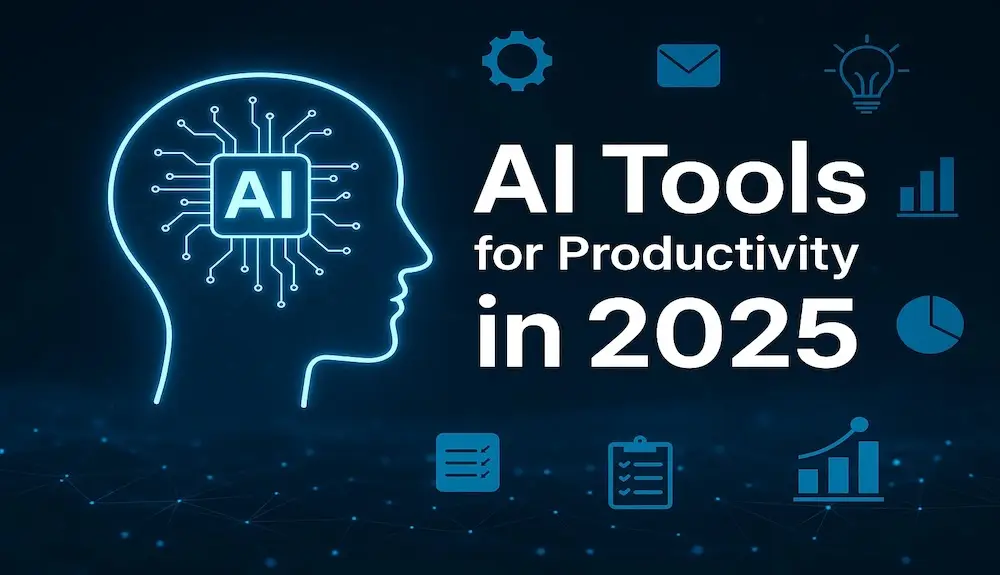In 2025, productivity isn’t just about working faster — it’s about working smarter. As someone who’s led IT transformations through multiple technological eras, I’ve seen firsthand how AI tools evolve from novelties to necessities. The difference between thriving and surviving now hinges on selecting the right tools for the right teams. Below, I dissect 10 AI tools that are reshaping work in 2025, their ideal users, and how they create enterprise-wide value.
1. ChatGPT-4o: The Cross-Functional Collaborator
Target Audience: Customer support teams, content creators, developers, project managers.
Core Capabilities:
- Generates code snippets, technical documentation, and customer responses.
- Integrates with Jira, Salesforce, and SAP for context-aware task automation.
- Customizable via no-code interfaces for department-specific workflows.
Strategic Value:
Eliminates repetitive tasks like ticket triage (saving 15+ hours/agent weekly) while maintaining human oversight for complex issues.
Use Case:
A telecom company deployed ChatGPT-4o to auto-generate network outage reports, reducing manual work by 70% for NOC teams.
2. Claude 3: The Ethical Analyst
Target Audience: Legal teams, compliance officers, R&D departments.
Core Capabilities:
- Analyzes 150K+ token documents (contracts, research papers) with citation tracing.
- Redacts sensitive data in real time for GDPR/HIPAA compliance.
- Flags logical inconsistencies in technical proposals.
Strategic Value:
Reduces legal review cycles from weeks to days while minimizing regulatory risks.
Use Case:
A biotech firm used Claude 3 to audit 20,000+ clinical trial records, identifying 12 critical compliance gaps missed by human reviewers.
3. Notion AI Q&A: The Institutional Memory Engine
Target Audience: HR, sales, and product teams (but truly ANY team that’s already using Notion).
Core Capabilities:
- Searches across Confluence, SharePoint, and Slack to answer employee queries.
- Auto-generates onboarding playbooks and competitive battle cards.
- Tracks knowledge gaps to recommend upskilling resources.
Strategic Value:
Cuts new hire ramp-up time by 40% and reduces duplicate work across distributed teams.
Use Case:
A global consultancy reduced proposal drafting time by 50% by using Notion AI to surface past project templates and pricing models.
4. Otter.ai: The Meeting Intelligence Hub
Target Audience: Executives, sales teams, remote employees.
Core Capabilities:
- Generates searchable meeting transcripts with speaker identification.
- Extracts decisions, risks, and action items into Asana/Trello tasks.
- Highlights emotional tone shifts during negotiations.
Strategic Value:
Ensures alignment in hybrid work environments and creates auditable records for compliance.
Use Case:
A venture capital firm uses Otter.ai to analyze partner meeting dynamics, improving conflict resolution speed by 65%.
5. Fireflies.ai: The Sales Execution Partner
Target Audience: Sales leaders, account managers, customer success teams.
Core Capabilities:
- Analyzes call patterns to predict deal health and churn risks.
- Auto-generates follow-up emails with personalized next steps.
- Integrates with Gong and Outreach to refine playbooks.
Strategic Value:
Increases win rates by 25% through real-time deal coaching and pipeline transparency.
Use Case:
A SaaS company reduced sales cycle time by 30% by using Fireflies’ AI-generated objection-handling scripts during discovery calls.
6. Motion: The Operational Efficiency Architect
Target Audience: Operations managers, IT teams, engineering leads.
Core Capabilities:
- Optimizes resource allocation across projects using constraint-based algorithms.
- Simulates “what-if” scenarios for capacity planning.
- Auto-reschedules tasks when priorities shift.
Strategic Value:
Reduces project overruns by 45% and improves cross-team bandwidth utilization.
Use Case:
A manufacturing plant eliminated $1.2M in overtime costs by using Motion to balance maintenance schedules with production demands.
7. Reclaim.ai: The Workforce Sustainability Guardian
Target Audience: HR, department heads, overburdened ICs.
Core Capabilities:
- Blocks focus time based on circadian rhythms and workload intensity.
- Detects burnout patterns through calendar analytics.
- Syncs with wellness apps like Headspace to suggest mental health breaks.
Strategic Value:
Reduces voluntary attrition by 30% in high-stress roles like IT support and consulting.
Use Case:
A law firm reduced associate turnover by 22% after Reclaim.ai identified teams averaging >60-hour weeks and rebalanced caseloads.
8. Grammarly Enterprise: The Communication Consistency Enforcer
Target Audience: Marketing, PR, customer-facing roles.
Core Capabilities:
- Ensures brand voice alignment across 100+ content creators.
- Detects inclusivity issues (e.g., biased language) in real time.
- Provides ESL coaching for global teams via interactive writing feedback.
Strategic Value:
Accelerates global campaign launches by standardizing messaging across regions.
Use Case:
A luxury retailer maintained brand tonality across 15 languages using Grammarly’s AI style guides, avoiding $500K+ in rebranding costs.
9. Jasper: The Content Velocity Accelerator
Target Audience: Content marketers, SEO specialists, social media teams.
Core Capabilities:
- Generates performant blog outlines optimized for target keywords.
- Repurposes webinar transcripts into LinkedIn carousels and TikTok scripts.
- A/B tests email subject lines against historical open-rate data.
Strategic Value:
Triples content output without compromising quality, driving organic traffic growth.
Use Case:
An e-commerce brand scaled from 50 to 300 blog posts/month using Jasper, increasing leads by 200% in 6 months.
10. Cisco AI Assistant for Webex: The Collaboration Equalizer
Target Audience: Remote/hybrid teams, global project leads.
Core Capabilities:
- Translates meetings in real time across 40+ languages.
- Generates executive summaries with revenue impact highlights.
- Integrates with ServiceNow to auto-create IT tickets from discussions.
Strategic Value:
Closes the experience gap between in-office and remote employees, fostering inclusive innovation.
Use Case:
A tech giant reduced miscommunication errors by 55% across 10 global R&D hubs using Webex’s AI-generated meeting digests.
Critical Success Factors: Turning AI Tools into Enterprise Value
Adopting AI productivity tools is not a matter of simply acquiring licenses or deploying new software. The difference between organizations that unlock transformative value and those that get stuck in “pilot purgatory” comes down to several critical success factors. These factors are rooted in strategy, culture, data, governance, and continuous learning. Use the following table as a guide:
| Success Factor | Why It Matters | Actionable Example |
| Business Alignment | Ensures AI tools solve real business problems | Map tool adoption to specific KPIs and pain points |
| Executive & Cross-Functional Buy-In | Drives adoption, breaks silos, and secures resources | Involve C-suite and business unit leaders from the start |
| Focused, High-Impact Pilots | Demonstrates quick wins and builds momentum | Launch pilots in areas with clear, measurable outcomes |
| Data Quality, Accessibility, Security | AI effectiveness depends on robust, secure data | Invest in data governance and privacy controls |
| Upskilling & AI Fluency | Reduces resistance and maximizes tool value | Offer ongoing training and create AI “centers of excellence” |
| Robust Governance & Responsible AI | Minimizes risk and ensures ethical, compliant use | Establish AI ethics committees and regular audits |
| Modern Infrastructure & Integration | Enables scalability and prevents workflow disruption | Upgrade legacy systems and prioritize seamless integration |
| Cross-Department Collaboration | Ensures solutions are practical and widely adopted | Form cross-functional teams for tool selection and rollout |
| Continuous Measurement & Iteration | Sustains long-term value and adapts to change | Track KPIs, gather feedback, iterate, and sunset failures |
| Long-Term Investment & Change Mgmt | Embeds AI into the organization’s DNA for lasting impact | Budget for ongoing AI, upskilling, and change management |
By focusing on these ten critical factors, organizations can move beyond pilot projects and ensure AI tools become sustainable drivers of productivity, innovation, and competitive advantage.
The Critical Question for Decision-Makers
Are your teams simply using AI tools, or are you building a culture where AI-driven productivity is continuously measured, improved, and scaled across your organization?
If your organization is systematically aligning AI adoption with business goals, investing in upskilling, and iterating based on measurable outcomes, you’re on the path to sustainable, enterprise-wide productivity gains. If not, now is the time to rethink your approach — before your competitors set a new standard.
Final Thought
In 2025, productivity isn’t a personal goal — it’s an organizational mandate. The question isn’t whether to adopt these tools, but how quickly you can turn them into competitive leverage. The clock is ticking.




